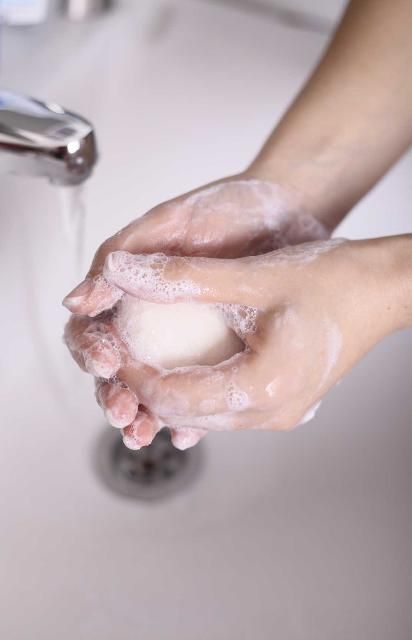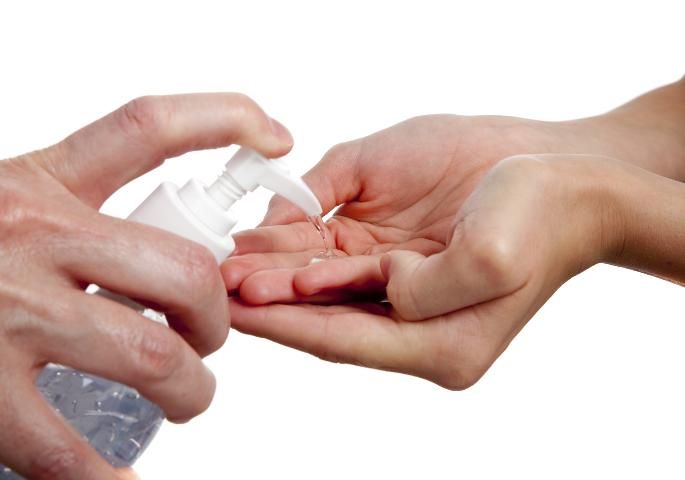Introduction
Hand hygiene is one of the primary methods used to reduce the fecal-oral transmission of infectious agents. However, conflicting hand hygiene recommendations for different settings are causing confusion among the general public as to what is the best practice to follow or what products should be used for daily handwashing and hand hygiene. This document provides the information necessary for average consumers to make an informed decision.

Credit: PeopleImages/istockphoto.com
Understanding Your Immediate Environment
Many people have the misconception that their immediate environment must be germ-free. However, this is only possible in a true germ-free chamber in a lab or in certain hospital settings. We live in a natural world that is full of microorganisms, living things that cannot be seen by our bare eyes. While some of the microorganisms can cause illness or diseases, others can be essential to our environment and wellbeing. Although some microbes can cause food spoilage or diseases, many of them are a natural part of our foods and environments.
Without good bacteria, you would be without your favorite yogurt, sauerkraut, or certain medicines! Cows would not be able to use grasses for energy without good microbial partners. And without good bacteria or fungi, our earth would be full of yard waste and other biological trash. Furthermore, we should not forget that our normal, healthy body has various external barriers and internal mechanisms (immune system) to fight germs, as long as their numbers are not overwhelming.
So, understanding and learning how to control or deal with both the good and the bad microorganisms on our body and in our environment can help us make good use of those microbes, and at the same time, limit the spread of communicable diseases. The goal is to reduce the number of bad microbes to a level low enough for the body to reasonably fight them off with its existing immune system.
The Body's Bugs
The body parts of healthy humans and animals are hosts to a variety of microbes known as resident microbes. But through contact with other objects, the body also picks up other microbes known as transient microbes. For example, a typical person's hand can carry 10,000 to 10 million bacteria, some resident and some transient. When humans or animals are sick or infected with specific microbes, the number of microbes may increase.
The skin is not the only host area on our bodies for bacteria and other microbes. Many microbes are also present in the intestinal tracts of humans and animals. These are known as fecal microorganisms. A person's hands, arms, or fingers may become contaminated with fecal microorganisms after using the toilet. These must be removed by the mechanical friction of washing with soap and water or destroyed by the use of antiseptic solutions. The microorganisms from human and animal sources can be transmitted to hands, other people, foods, and anything else that the hand comes in contact with and vice versa. This is why good hand washing is important for reducing harmful microorganisms on our hands and for reducing the risk of transferring harmful microorganisms to others.
How to Determine which Handwashing Method to Use
Recommendations for handwashing and hand sanitation for different groups of people can vary depending on their job functions and their personal health requirements. Research has shown that hand sanitizers can be as effective as handwashing only in certain situations. The type of soil that may be present on hands can significantly alter the effectiveness of hand sanitizers. Because dirt, food, or anything else on your hands can make the alcohol in sanitizers less effective, it is important to first wash your hands with soap and water.
Some confusion occurred when the Centers for Disease Control and Prevention (CDC) released the 2002 guidelines "recommending alcohol-based gel as a suitable alternative to hand washing for health-care personnel in health-care settings." Many healthcare workers must routinely clean their hands multiple times per hour while moving between patients. The use of alcohol gels by staff has been shown to favorably impact hand-cleansing adherence due to time saved over traditional hand washing methods. However, the guidelines apply only to hospitals and clinics. These are not appropriate for and do NOT apply to those people working in foodservice settings or with the general public. The primary reason is that the types and levels of soil on the hands are quite different between these different settings.
In a food service setting, fecal bacteria and enteric viruses, such as Norovirus, are more of a concern. Food workers often have wet hands and hands contaminated with food high in proteins and/or fatty materials. Food proteins and fatty materials can significantly reduce the effectiveness of an alcohol gel. Therefore, soap, friction, and running water still remain the most effective way to remove the types of pathogens food workers might encounter. The FDA Model Food Code Rules and Regulations make the provision that hand sanitizers may be used by food workers in addition to, but not in place of proper hand washing. Because hand sanitizers are considered to be a food additive, only products approved by the FDA may be used.
Handwashing guidelines for healthcare workers should not be confused with recommendations for food workers or the general public. For everyone, washing hands with soap and water is sufficient and is still a must. For the general public at home, plain soap and water is adequate for most consumer uses. Dr. Elaine Larson recommends taking the extra precaution of using an alcohol gel or antibacterial soap only in situations such as:
-
coming in close physical contact with persons at high risk for infection (such as newborns, the very old, or immunosuppressed);
-
having direct physical contact with someone with an upper respiratory infection, skin infection, or diarrhea; and
-
working in settings where infectious diseases are commonly transmitted, such as food preparation, and/or crowded living areas (childcare centers, preschools, prisons, or chronic-care residences).
How Different Soaps and Hand-Cleaning Products Work
Chemically speaking, "soaps" are water-soluble sodium or potassium salts of fatty acids that have important properties as surfactants. Detergents are synthetic compounds of a different class than soaps, but which share similar surfactant properties. In the cleaning process, soaps or detergents help reduce surface tension. They make water mix better with dirt and soil on surfaces and skin. Through their ability to loosen and remove soil from a surface or from skin, they contribute to good personal hygiene by reducing the presence of germs that cause infectious diseases. Many soap-based cleaning products are formulated with other ingredients to deliver cleaning functions as well as other specific desired properties. Depending on the other ingredients, they may also moisturize the skin and/or kill or inhibit bacteria that can cause odor or disease. Plain soap is used primarily in the mechanical removal of transient microorganisms whereas antimicrobial products are used for the mechanical removal and killing or inhibition of both resident and transient microbes.

Credit: neolamprologus/istockphoto.com
Antimicrobial soaps contain an antiseptic agent to help lower the number of microbes, in addition to mechanical removal. However, an important key factor in the effectiveness of these soaps is the length of time they are left on the skin and the concentrations of the products. Companies have not published information on what combination of triclosan concentrations and washing times are most effective, so it is difficult to know which brands work best. Chloroxylenol (also known as parachloromethxylenol) is another antimicrobial compound found in some antibacterial soaps. There is concern that use of antimicrobial soaps may lead to bacterial resistance. While in theory this remains possible, research thus far has not found evidence that this is happening. With the recently released final rules on safety and effectiveness of consumer antiseptic rubs from the FDA, many antiseptic ingredients will change over time and consumers will need to be vigilant about the active ingredients.
Like other consumer products, soap with high price may not be the best of quality. Therefore, knowing the different products and their ingredients helps you select the right product for the cleaning job and for the right price.
Can a Hand Sanitizer (Alcohol Gel) Substitute for Handwashing?
The majority of alcohol-based sanitizers in the United States contain ethanol or isopropanol or a combination of these two products. Most brands also contain a moisturizer to minimize irritation to the skin. Alcohol works immediately and effectively to kill bacteria and most viruses. The antimicrobial activity of alcohol is its ability to change proteins in microorganisms. Proteins and fats on soiled hands will decrease the effectiveness of alcohol as a sanitizer. Alcohol solutions containing 60%–95% alcohol are the most effective. Higher concentrations are less potent because proteins are not denatured easily without water.
Alcohol gels work by stripping away the outer layer of oil on the skin, thereby destroying any transient microorganisms present on the surface of the hands. After use, regrowth of bacteria on the skin tends to occur slowly, thereby effectively keeping "residual" microflora that reside in deeper layers of skin from coming to the surface. To be most effective, a dime-size dollop of alcohol gel should be rubbed into the hands for 30 seconds. If hands are dry after only 10–15 seconds, it is likely that not enough sanitizer was used.

Credit: miflippo/istockphoto.com
Hand sanitizers should primarily be used only as an optional follow-up to traditional hand washing with soap and water, except in situations where soap and water are not available. In those instances, use of an alcohol gel is certainly better than nothing at all.
References
CDC. (2002). "Guideline for hand hygiene in health-care settings: Recommendations of the Healthcare Infection Control Practices Advisory Committee and the HIPAC/SHEA/APIC/IDSA Hand Hygiene Task Force." MMWR, 51 (RR-16), 1–48. https://www.cdc.gov/mmwr/PDF/rr/rr5116.pdf
FDA/HHS. 2019. Safety and Effectiveness of Consumer Antiseptic Rubs; Topical Antimicrobial Drug Products for Over-the-Counter Human Use. https://www.federalregister.gov/documents/2019/04/12/2019-06791/safety-andeffectiveness-of-consumer-antiseptic-rubs-topicalantimicrobial-drug-products-for (August 2019)
FDA/HHS. 2018. Retail Food Protection: Employee Health and Personal Hygiene Handbook. https://www.fda.gov/food/retail-food-industryregulatory-assistance-training/retail-food-protection-employee-health-and-personal-hygiene-handbook (February 2022)
Larson E.L. 1995. "APIC guidelines for handwashing and hand antisepsis in health care settings." Am J Infect Control 23:251–269. https://doi.org/10.1016/0196-6553(95)90070-5
Larson, E. 2001. "Hygiene of the Skin: When is Clean Too Clean?" Emerging Infectious Diseases 7(2):225. https://doi.org/10.3201/eid0702.010215
Paulson D.S. 1994. "A comparative evaluation of different hand cleansers." Dairy Food Environ Sanit. 14:524–28.
McSwane, D., Rue, N., and Linton, R. 2000. Essentials of Food Safety & Sanitation. 2nd, Prentice Hall. NJ.
Paulson, D.S. 1998. "Comparison of Hand Washing Products." Dairy, Food and Environmental Sanitation 14:(9):524.
Snelling A.M., Kerr K.G., Heritage J. 1991. "The survival of Listeria monocytogenes on fingertips and factors affecting elimination of the organism by hand washing and disinfection." J Food Protect. 54:343-348. https://doi.org/10.4315/0362-028X-54.5.343
VanDenmark, P.J. and Batzing, B.L. 1987. The Microbes: An introduction to their nature and importance. The Benjamin/Cumming Publishing Company, Inc. Reading, MA.